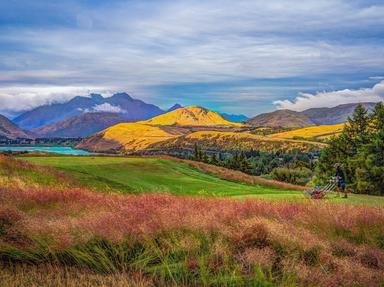Quiz Answer Key and Fun Facts
1. What is the name of the bay on the east coast of the South Island which stretches gently from Banks Peninsula some 100 miles north?
2. Wellington sits on a huge, almost circular, harbour usually thought of as Port Wellington or just Wellington Harbour. But that's not its only name. Do you know what its other name is?
3. When you travel south from Haast in the South Island, you eventually cross the Arawhata River, turn right, and half a mile later you reach a bay at the end of the road. Where are you?
4. Mitre Peak is the most striking feature of the shoreline in which large South Island inlet?
5. Captain James Cook of HMS Endeavour named Hawke's Bay after Admiral Hawke, who had given some ships of the French navy a hiding a few years before. In 1931 an event occurred which probably made the locals regret moving there. What happened?
6. This nearly-enclosed bay in the north of the North Island saw the beginnings of European immigration and of colonial government in New Zealand. The first capital, Russell, was built on its shores. Which bay is it?
7. At the bottom of the South Island there is a bay which looks as if a monster has taken a nearly semi-circular bite out the land; or that a small meteorite landed locally. The Waiau River flows into it and the town of Tuatapere is slightly inland of it. What is it called?
8. The lower part of the western North Island can be regarded as one huge bay, as the coastline curves around from Waikanae in the south to Taranaki in the north. And it has a name. Think of teeth ... What is the name?
9. In November 1990 a local man went on a shooting spree in this township, killing thirteen people and wounding three others. He was eventually shot by police and died on the way to hospital. Where was this?
10. In 1642 Abel Tasman attempted to land at this bay at the northern end of the South Island. However, his boat was attacked by Maoris in canoes and four of his seamen died. Tasman called the inlet Murderers' Bay, but it now has a different name. What is it?
11. Young Nick's Head was named by that busy fellow, Captain Cook, after the lookout who first spotted landfall in New Zealand in 1769. Cook received a very cold welcome when he landed shortly afterward. The headland marks the southern end of Poverty Bay. Yet the district was far from "poor". What is it best known for today?
12. This bay is bounded by the Coromandel Peninsula on one side, and the mainland on the other. At the southern end is the town of Thames. What is the name of the bay?
13. Doubtful Sound, in Fiordland (South Westland) was originally named Doubtful Harbour by Captain Cook. Why did he choose this name?
14. What is the name of the town at the head of Queen Charlotte Sound which is the southern terminal for the Cook Strait ferry service?
15. This "bay" is really a wide river estuary on the west coast of the northern North Island. It has mangroves growing along its shores and is surrounded by forests, including Waipoua kauri forest. It played a prominent part in Maori mythology. Which bay is it?
Source: Author
capfka
This quiz was reviewed by FunTrivia editor
Tizzabelle before going online.
Any errors found in FunTrivia content are routinely corrected through our feedback system.

